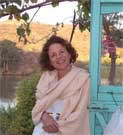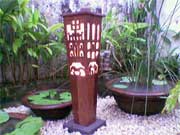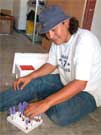This is the old Ternyata site, maintained for archival purposes. You can see the new site at http://www.ternyata.org
By ELIZABETH PISANI
2014 words
26 June 1996
Asia Times
(c) 1996 Chamber World Network International Ltd
A demanding World Bank with a newfound environmental conscience has suddenly emerged with life-and-death power over a gigantic dam project in central Laos.
At issue is the Nam Theun 2 project which will flood 450 sq km of forest land, generate 681 megawatts of electricity for sale to Thailand and, at US$1.2 billion, cost nearly as much to build as the Southeast Asian country earned last year.
The project's developers want to borrow money from commercial banks to pay for the project. But bankers are nervous about lending huge amounts to put fixed assets in a socialist country for a long-term project which would rely on Laos' neighbor, Thailand, for income.
They are counting on the World Bank to soothe bankers' nerves. Political risk guarantees, a relatively new item on the Bank's menu, would guarantee that lenders would get their money should Laos' uncertain political future turn sour.
Before it agrees to be involved, however, the bank has been making both the Lao government and developers jump through a series of environmental, social and economic hoops. "Some of the studies required are a nonsense," said Stephen Wermert, of arranger Deutsche Bank. "It is just part of the price you pay for dealing with the World Bank."
In the eight months since the bank laid out its conditions, the government has not done anything on the two studies assigned to it - one on alternatives to Nam Theun 2 and another on its economic effects.
This, said state power company Electricite du Laos (EDL) general manager Vira phonh Viravong, was partly because the Bank's de mands have ann oyed many.
"Before, only en gineers made de - cisions about dams. Now the economists, the environmentalists, everybody wants to have a say," Viraphonh said. "It may be a natural development, but when the World Bank says it wants this and this and this, it is very much resented by some of the ministers."
To qualify for a guarantee, Laos would have to agree to play by certain rules. "Like everyone else, the Laotians have their ego," said Apinya Suebsaeng, of the Bank's private sector lending wing, the International Finance Corporation (IFC). "Being dictated to is not a pleasant prospect," she said.
Developers have been all praises for the project. The unusual topography of the area means they will be able to build a dam wall only 50 meters high, then drop the water 300 meters down an escarpment further up the reservoir for far greater generation capacity.
"It is the most economical hydropower project any of the developers have ever seen," said David Iverach, environment director for the project development group.
Australia's privately-owned Transfield leads the developers' group although it holds only 10 percent of the project. Electricite de France, the world's largest operator of hydropower stations, holds 30 percent, with the Lao government owning one quarter. The remaining 35 percent is in Thai hands. Blue-chip construction company Ital-Thai has 15 percent, while telecommunications company Jasmine and Phatra Thanakit investment company hold 10 percent each.
With no fuel costs and operating overheads as low as two percent, according to some specialists, the bill for hydro projects has been dictated by the price of construction and money. Building Nam Theun 2 would cost between US$700 million and US$800 million, developers said. The bulk of the remainder would go to the cost of money.
And that depends ultimately on crucial World Bank guarantees which would bring in the big international commercial banks. The banks that are seeking to arrange the financing include Barclays, Societe General and Deutsche Bank.
Project developers expect the World Bank to guarantee about US$100 million worth of loans, with export credit agencies falling in behind them with another quarter of a billion. The government will likely finance its own US$90 million equity stake with funds borrowed from the Thai Export-Import Bank.
If the World Bank holds back its guarantee, the whole picture would change. "International banks will not be prepared to accept risk on that scale," Singapore-based project finance specialist Pierre Bosse said.
An important wild card is the IFC, whose protective umbrella might bring in money even if the World Bank stays out. "The IFC looks at it like a business, and if they think it is economically sound and not detrimental to the environment they may choose to be involved," said Henri Bretaudeau of the World Bank's energy department.
The IFC said everything would depend on the World Bank's reason for turning down the loan. "If it were for serious environmental reasons, then I think everyone would run for cover," said the IFC's Apinya. If, however, the Bank pulled out simply because it was unable to resolve a debate about which countries should be eligible for political risk coverage, he said, then other financial institutions might go ahead.
But at what cost? Unlike the World Bank, the IFC does not work to a fixed price list but sets its lending rates according to the project risk. "As a matter of strategy, you don't go around talking about alternatives until you are absolutely sure your Option 1A doesn't work," Apinya said.
At least one of the developers of the 25-year build-own-operate-transfer project said nothing short of World Bank support would do in any case. "If we can't get World Bank backing, Transfield will not be in this consortium," Iverach said.
The cost of funds obviously affects returns all round. The Lao government will put up a quarter of the 30 percent of the funding that is in equity, but get 50 percent of the revenues for the 25-year concession period. That, said developers, should put more than US$1 billion into coffers in the first 25 years, and about US$400 million a year after that.
Some said the developers' own returns, placed at 17 or 18 percent a year by EDL, were indecently high. "But after all, they are taking the risk," said Viraphonh. "And it is becoming very costly for them because of this delay." Developers put returns slightly lower than that. "Although if we had known how hard it was going to be, we would have gone for something higher," said one developer bitterly.
The Nam Theun 2 consortium has sunk more than US$30 million into the project to date, equivalent to an extra 2.5 percent on financing costs. That was a powerful disincentive to pull out, bankers said. Developers disagreed, one of them saying: "You're jerking us around because you think we can't leave? Because you think we've spent too much money? Well, I tell you something. If this goes on we just take a legitimate tax write-off and move on to the next project."
If there is a change of ownership, bankers said the Electricity Generating Authority of Thailand (EGAT) - the client for electricity from Nam Theun 2 - would renegotiate.
Already, the Thais have driven a very hard bargain. EGAT is likely to be paying between US$0.052 and US$0.056 a kilowatt hour for electricity from other sources, but was able to wear developers down to US$0.455 an hour for Nam Theun 2 power, and will buy from Theun Hinboun at only US$0.043.
"After six months of negotiations, we thought, can we live with this? Or do we sit for another 10 years saying, 'sorry, the transfer pricing is wrong'?" said Viraphonh. "It is very expensive to be poor like us," he said with a sigh.
The deal will get progressively better for the Thais. The cost of power from Nam Theun 2 will rise at only 35 percent of the inflation rate. Developers have accepted it because if they borrow money at fixed interest rates, the cost of their debt repayments would fall in real terms over the life of the loan.
The consortium setup is a careful balance of Thai and other interests, but some bankers ex pected their Thai colleagues to pick up the slack if international banks get cold feet. "As long as the project is commercially feasible, people here aren't so worried about Laos' country risk. They think it is all part of Thailand anyway," a foreign merchant banker said.
Some believed the vacillation was because World Bank is balking at the thought of financing Thailand. "Basically, World Bank money will subsidize the growth of Thai industry, which is something that the Thai private sector is perfectly capable of financing it self," said a Bangkok banker.
"That may be very true, but it is also very naive," said EDL's Viraphonh. "If we can't sell power to Thailand, what do we do then?"
For all the economic and political concerns swirling around the project, the loudest criticism has come - as is always true with hydro projects that flood large areas - from environmental and community development groups.
Aware of this, project developers have invested in a spin-control team which has argued that more wildlife would survive with the dam than without it since it is firmly in developers' commercial interest to preserve the 4,000 sq km watershed that feeds the reservoir and the turbines.
The project, which will spend about US$1 million a year to protect the catchment area, has the support of the Wildlife Conservation Society. A non-governmental org - anization, WCS has defended the dam in a shrill public debate with the International Rivers Network, a United States-based environmental advocacy group which has been vocal in its opposition to Nam Theun 2.
Many Laos-based NGOs resent being labeled "anti-dam" simply for asking questions about the project. "A US$1.2 billion project doesn't collapse because of a few NGOs," said an Australian development worker.
In a lengthy memo written last November, the bank said the project as it was then conceived would be hard to support. It called on developers to demonstrate that biodiversity would actually be improved by the project and that the people in the area would end up better off with the dam than without it.
"Baseline surveys show that families on the plateau are worse off in almost every way than the average Lao family," said Iverach of the developers group. To a certain extent, that is the project's fault. Families that once did live off the forest have seen it cut down by the military-owned Mountainous Area Development Group (or BPKP, its Lao initials - see box). They have been promised better lives elsewhere and were keen to move as a result. "What worries us is that it is not clear who is responsible for meeting all the expectations that now exist," said development worker Charlie Pallman.
People on all sides of the debate worry that pulling the rug from under a development group with blue-chip credentials may simply lead to a less accountable consortium taking over. "If you knock out the international agencies and corporations which are responsive to pressure, the next level down doesn't give a damn," said Stuart Chape, of the International Union for the Conservation of Nature (IUCN).
In the end, Laos will have to get foreign exchange from somewhere. "The need is urgent and the scope is limited. The options have somehow to be based on natural resources," said an environmentalist, listing mining and timber, both "potentially more damaging to the environment".
Whatever the alternatives, the screws are on the bank to keep its environmental record clean. That makes Laos, which wants an undertaking that it would not be abandoned if they went ahead with the project, nervous. Some think the bank may have decided that hydro was just too politically difficult, though some in the bank are still prepared to stand up for hydro. This leaves developers alternating between hope and despair.
Copyright 1996 Asia Times.
(c) 1996 Chamber World Network International Ltd
Thanks
|




